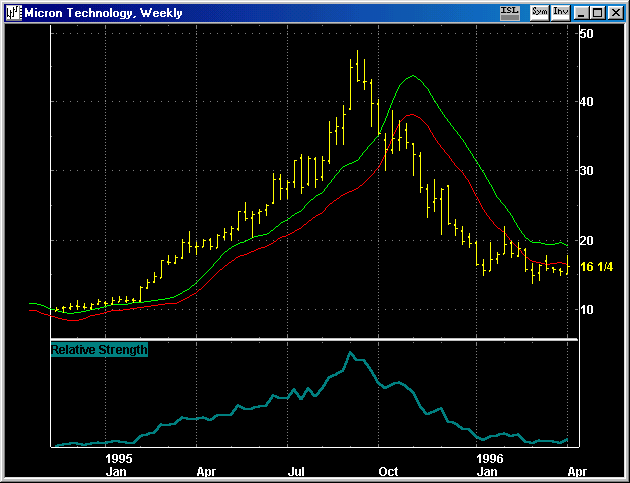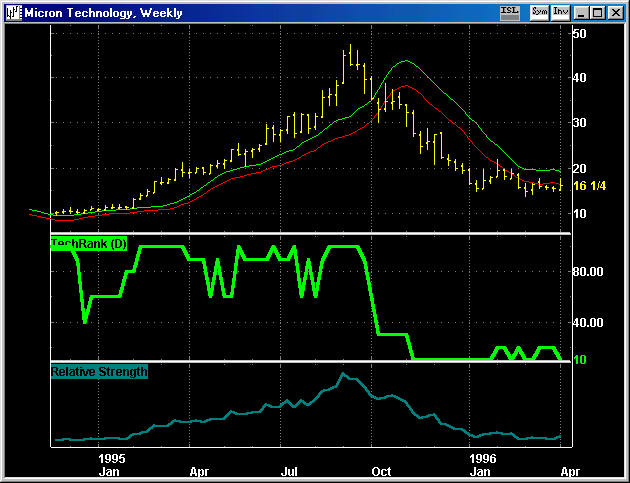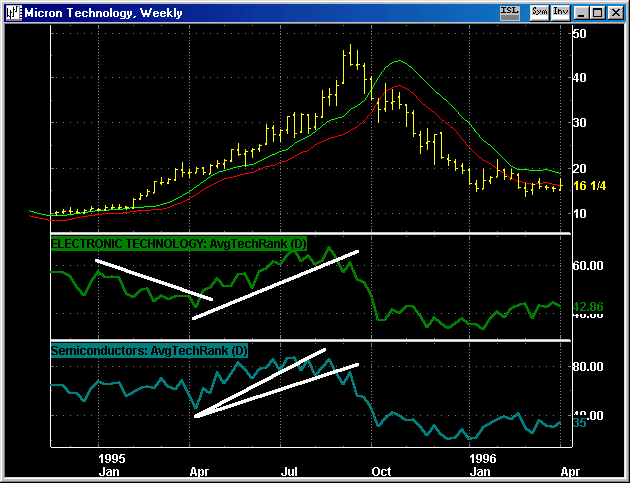|
RELATIVE STRENGTH
The Erlanger Technical Rank
Relative strength is a time tested tool of technical analysis.
Not to be confused with the RSI oscillator, relative strength is
simply the price of a stock divided by and index (usually the S&P
500). A rising relative strength trend depicts a stock who's price
action is better than the average stock. A declining relative strength
trend uncovers weakness "relative" to the average stock.
The attractive nature of relative strength analysis is that such
trends tend to persist. This is easy to understand... we may not
fully understand why a trend is in force, but if the relative strength
is strong (or weak) enough, the forces at work behind these trends
are likely not random, and therefore have some lasting effect. Because
trends of relative strength tend to persist, when they do change,
this is a significant event.

This chart shows the relative strength for Micron Technology (MU)
when it had its parabolic climb back in the mid 1990s. This is a
classic study of relative strength trends persisting.
THE ERLANGER TECHNICAL RANK
The Erlanger Technical Rank is a nonlinear representation of a
stock's relative strength line. It is on a scale of 10% to 100%
- with increments of 10% only. Each of these 10 measures (10%, 20%,
30%...100%) is in actuality a separate relative strength pattern
or shape. 10% is the worst shape while 100% is the strongest. The
higher the Technical Rank, the stronger price action of the underlying
stock relative to the average stock.
Here is the chart of MU with its Technical Rank:

One of the great features of the Technical Rank is that it is normalized
- that is, one can compare one stock's Technical Rank to another.
One of the advanced series of Erlanger data is compositing the Technical
Rank into Groups and Sectors.
ERLANGER TECHNICAL RANK OF GROUPS AND SECTORS
A very helpful tool is the Average Technical Rank of groups and
sectors. Because our group and sector measures are arithmetic, any
group and sector observation is not capitalization weighted - this
enables a truer measure of group and sector trends. IT IS BEST NOT
TO GO AGAINST AN OBSERVED GROUP OR SECTOR TREND.

The above chart shows both the group (semiconductors) and sector
(electronic technology) average Technical Rank for MU. Being long
when these measures are in uptrends and while the stock price is
above the DMAs (displaced moving average lines) worked quite well
in an otherwise psychologically difficult stock to trade. The reverse
is also true - shorting while these group and sector average Technical
Ranks declined and while the stock price was below the DMAs was
timely.
|





